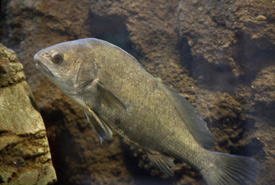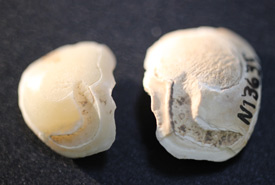The sheepshead: A true Great Lakes underdog

Freshwater drum swimming (Photo by Florida's Online Educational Clearinghouse)
I grew up a mere hour’s drive from majestic Lake Erie, and that meant lots of great fishing. The biggest thrills came when my dad and grandfather hired a charter boat to take us out for a day of reeling in Erie’s best game fish, including walleye, perch and smallmouth bass. We caught plenty of those fish but we also caught a hard fighting, yet sadly unwanted (at the time) guest: the freshwater drum, known in the Great Lakes region as the sheepshead.
The sheepshead is the only freshwater-dwelling member of the Scianidae family, a group of primarily coastal marine species that includes popular sport fish such as the red drum. For centuries, native peoples in the Great Lakes region ate sheepshead and made its unique otolith (ear bone) into jewellery commonly called a "lucky stone," which modern Great Lakes residents continue to seek out. Yet anglers and commercial fishers alike have long dismissed the freshwater drum as a nuisance undeserving of either a food or a sport fish status.

Otolith drum ear bones (Photo by the Ohio History Connection blog)
This is a shame, because in addition to being a fascinating species, the sheepshead is a tough fighter at the end of a line, a worthy addition to a summer fish fry and a welcome consumer of the notorious zebra mussel, which is among the most prominent of Great Lakes invasive species.
Freshwater drums are a pearl-grey colour with the occasional bronze, blue and silvery reflections, depending on the quality of water they live in. Mature freshwater drums sport a prominent humpback. This species inhabits the Great Lakes and Mississippi river drainages stretching from eastern and central Canada all the way down to Louisiana in the southern United States. The species prefers deep water in both lakes and rivers and spawns in mid-summer.
Although often classified as a bottom-feeding “rough fish,” freshwater drums lack the sucking mouths of carp and suckers. They feed on insect larvae and invertebrates such as leeches and have a special taste for shelled mollusks. They use powerful sets of teeth located in their pharynx to crack open shells, which they spit out after consuming the mollusk’s body. Like all drums, the freshwater variety have a physoclistus swim bladder (a swim bladder that is unconnected to the digestive tract), which they use to make the distinctive drumming sound that gave them their name. They max out at over 35 pounds and can live for at least 14 years.
Freshwater drum goes by a number of regional names. Sheepshead is the preferred nomenclature in the Great Lakes (possibly due to their teeth), while Manitobans commonly label the fish a silver bass. In the American South, anglers refer to the drum by the curious moniker “Gasper Goo,” likely a phonetic English pronunciation of the Cajun French term “caszburgot,” first used by French Louisianans in the 1700s.

Freshwater drum (Illustration by the New York Department of Environmental Conservation)
For too long, Great Lakes residents have held the sheepshead in contempt due to the frequency with which it takes bait intended for other game fish, as well as for as its alleged inferior taste. I myself recall having loads of fun hooking sheepshead on Lake Erie charter boats, only to shamefully dismiss my hard-battling adversaries when they broke the waves to reveal themselves in all of their non-walleye glory.
Looking back now, this reaction was strangely misguided. After all, those drum (which we always released) provided a first-class angling experience, and there I was, chiding them for merely being themselves. Furthermore, even when the more finicky game fish refused to grace us with their presence, the sheepshead were always eager to bite.
The good news is that in recent years the sheepshead’s reputation has gradually been rehabilitated in the eyes of anglers and conservationists alike.
During the summer of 2015, for example, Michigan State University published an article touting the benefits of well-prepared drum fillets, sentiments echoed a year earlier by a Wisconsin food journalist. Moreover, in 2012 the renowned U.S. angling magazine In-Fisherman ran a tribute to Gasper Goo’s worthiness as a game fish. Clearly, the sheepshead’s time in the sun is overdue.
Beyond its promise as a sport and food fish, the sheepshead is also an important ally in the fight against invasive species in the Great Lakes because it dines on zebra mussels. These Eurasian bivalves have a nasty habit of filtering water to the point where it cannot support plankton, thereby wreaking havoc on native food chains. Natural predation by sheepshead may be one of the most effective ways to stop the mussels from spreading, so much so that the Winnipeg Free Press dubbed old Gasper “Our last, best hope” for controlling the aquatic striped hordes.
So the next time you consider the myriad of fish species the Great Lakes have to offer, leave a little spot in your heart for the sheepshead, the lakes’ most unappreciated and underutilized underdog.


